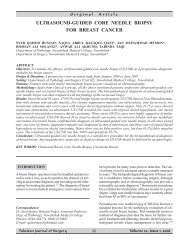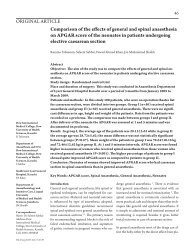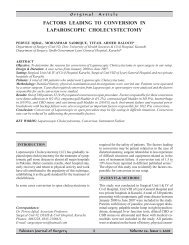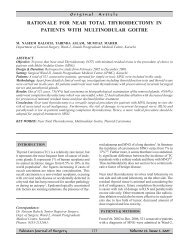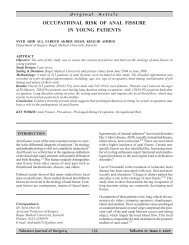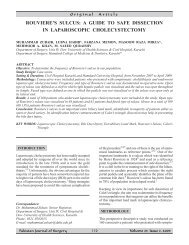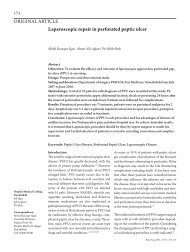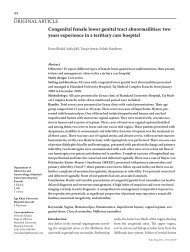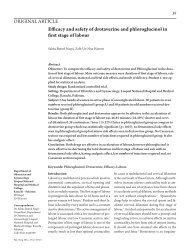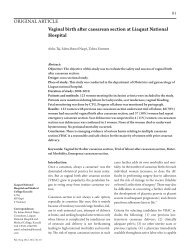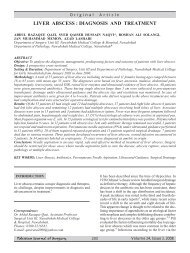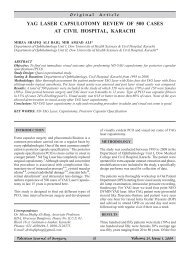Comparison of pupil dilation between intracameral lidocaine
Comparison of pupil dilation between intracameral lidocaine
Comparison of pupil dilation between intracameral lidocaine
You also want an ePaper? Increase the reach of your titles
YUMPU automatically turns print PDFs into web optimized ePapers that Google loves.
ORIGINAL ARTICLE<br />
<strong>Comparison</strong> <strong>of</strong> <strong>pupil</strong> <strong>dilation</strong> <strong>between</strong> <strong>intracameral</strong><br />
<strong>lidocaine</strong> & conventional topical mydriatics during<br />
phacoemulsification<br />
A. Rasheed Khokhar, Abdul Rahim<br />
142<br />
Abstract<br />
Objective: To compare the results <strong>of</strong> <strong>pupil</strong> <strong>dilation</strong> by an <strong>intracameral</strong> injection <strong>of</strong> non preserved<br />
<strong>lidocaine</strong> 1% during phacoemulsification cataract extraction and compare the results<br />
with those using conventional topical mydriatics.<br />
Setting: Department <strong>of</strong> Ophthalmology, Civil Hospital / Dow University <strong>of</strong> Health<br />
Sciences Karachi Pakistan .<br />
Methods: A prospective comparative case series study was conducted. The study included<br />
114 patients who were given topical mydriatics (60 eyes) or <strong>intracameral</strong> <strong>lidocaine</strong> (54eyes) to<br />
dilate the <strong>pupil</strong> for phacoemulsification and intraocular lens implantation. The topical group<br />
received 3 drops <strong>of</strong> cyclopentolate 1% and phenylephrine 5% given 5 minutes apart starting 60<br />
minutes before surgery. The <strong>intracameral</strong> group received preservative-free <strong>lidocaine</strong> 1% (0.2<br />
to 0.3 mL) injected just before the procedure began. No epinephrine was added to the irrigating<br />
solution. In both groups, the horizontal <strong>pupil</strong> diameter was measured before and after<br />
<strong>pupil</strong> <strong>dilation</strong> using the same caliper. Total surgical time, need for a mydriatic agent during the<br />
procedure, and subjective surgical performance were recorded.<br />
Results: The mean age, sex, cataract density, baseline horizontal <strong>pupil</strong> diameter, and mean<br />
duration <strong>of</strong> the surgery were the same <strong>between</strong> the topical group and <strong>intracameral</strong> group. The<br />
mean <strong>pupil</strong> <strong>dilation</strong> was 4.52 mm ± 0.08 (SD) in the <strong>intracameral</strong> group and 4.06 ± 0.09 mm in<br />
the topical group; the difference <strong>between</strong> groups was statistically significant (P=.001). There<br />
was no significant difference <strong>between</strong> groups in the overall subjective surgical performance<br />
(P=.74). No patient in the <strong>intracameral</strong> group and 4 patients in the topical group required an<br />
<strong>intracameral</strong> mydriatic injection<br />
Conclusion: During phacoemulsification, <strong>intracameral</strong> preservative-free <strong>lidocaine</strong> 1% provided<br />
rapid, effective mydriasis. This was comparable with that <strong>of</strong> topical mydriatics.<br />
Key words: Lidocaine, topical mydriatics, phacoemulsification<br />
Dow University <strong>of</strong> Health<br />
Sciences / Civil Hospital,<br />
Karachi<br />
AR Khokhar<br />
A Rahim<br />
Correspondence:<br />
Dr A Rasheed Khokhar<br />
Associate Pr<strong>of</strong>essor<br />
Dept <strong>of</strong> Ophthalmology<br />
Dow University <strong>of</strong> Health<br />
Sciences / Civil Hospital,<br />
Karachi<br />
Pak J Surg. 2010; 26(2):142-145<br />
Introduction<br />
Cataract surgery requires adequate mydriasis.<br />
This is usually achieved by topical and/or <strong>intracameral</strong><br />
administration <strong>of</strong> anti cholinergic<br />
agents, sympathomimetic mydriatic agents, or<br />
both, with the most common used being cyclopentolate,<br />
tropicamide, and phcnylephrine 1-2 .<br />
These regimens, however, have disadvantages<br />
such as slow onset <strong>of</strong> <strong>dilation</strong>, which increases<br />
the time before surgery can begin 3-5 , and adverse<br />
ocular and systemic effects, which are especially<br />
important in high-risk groups (eg, children, hypertensive<br />
patients) 6-8 . In addition, their effect<br />
has a tendency to dissipate during surgery 2 Intracameral<br />
injection <strong>of</strong> <strong>lidocaine</strong> has been used<br />
as an alternative to reduce the potential disadvantages<br />
<strong>of</strong> commonly used mydriatics. 9-10 This<br />
study assessed <strong>pupil</strong> <strong>dilation</strong> by an <strong>intracameral</strong><br />
injection <strong>of</strong> preservative-free <strong>lidocaine</strong> and<br />
compared the results with those <strong>of</strong> conventional<br />
topical mydriatics.<br />
Patients and methods<br />
A prospective comparative uncontrolled case
143<br />
series study in 114 patients with senile cataract<br />
scheduled for phacoemulsification and intraocular<br />
lens (lOL) implantation. Exclusion<br />
criteria were previous ocular surgery or laser<br />
procedures, iris abnormalities, pseudoexfoliation,<br />
systemic diagnosis affecting <strong>pupil</strong> <strong>dilation</strong><br />
such as diabetes mellitus or Homer’s syndrome,<br />
and use <strong>of</strong> topical ocular medications (except<br />
artificial tears). All patients signed an informed<br />
consent, and hospital ethics committee approval<br />
was obtained.<br />
The patients were randomly assigned to 1 <strong>of</strong> 2<br />
groups. The topical group was given 3 drops<br />
each <strong>of</strong> cyclopentolate 1% and phenylephrine<br />
5% at 5-minute intervals starting 60 minutes before<br />
surgery The <strong>intracameral</strong> group received 0.2<br />
to 0.3 mL <strong>of</strong> non preserved <strong>lidocaine</strong> 1% injected<br />
into the anterior chamber at the beginning <strong>of</strong><br />
surgery.<br />
In both groups, horizontal <strong>pupil</strong> diameter was<br />
measured with a caliper using the operating microscope<br />
in the operating room. Measurements<br />
were taken 1 hour before surgery in the topical<br />
group and just before surgery in the <strong>intracameral</strong><br />
group. The light intensity <strong>of</strong> the microscope<br />
was the same in both groups. The measurements<br />
were repeated with the same caliper just before<br />
surgery began in the topical group and 90 seconds<br />
after <strong>intracameral</strong> injection in the <strong>intracameral</strong><br />
group.<br />
All patients were given 3 drops <strong>of</strong> tetracaine 1%<br />
at 5-minute intervals before surgery. The procedures<br />
were performed by the same surgeon<br />
(AR.) using a quick-chop method11. Hydroxypropy<br />
methyl-cellulose 2% was used as an ophthalmic<br />
viscosurgical device and balanced salt<br />
solution (BSS) as the irrigating solution. In all<br />
eyes, a single-piece foldable IOL (AcryS<strong>of</strong>, Alcon)<br />
was implanted in the bag. No epinephrine<br />
was added to the irrigating solution.<br />
AR Khokhar, A Rahim<br />
Total surgical time, need for mydriatics during<br />
the procedure, and the subjective surgical performance<br />
were recorded at the end <strong>of</strong> the operation.<br />
Subjective surgical performance12 was<br />
graded during capsulorhexis, phacoemulsification,<br />
cortex aspiration, and IOL implantation on<br />
a scale <strong>of</strong> 0 to 2 (0 = uncomplicated; I = slightly<br />
complicated; 2 = complicated). Lens opacity<br />
was graded using the Lens Opacities Classification<br />
System Ill (LOCS Ill).<br />
Data were entered using SPSS s<strong>of</strong>tware (version<br />
11.5, SPSS, Inc.). An independent t test and<br />
Mann-Whitney U test were used for statistical<br />
analysis. A P value less than 0.05 was considered<br />
statistically significant.<br />
Results<br />
The topical group comprised 24 men and 36<br />
women with a mean age <strong>of</strong> 65 years ± 8.6 (SD)<br />
and the <strong>intracameral</strong> group, 24 men and 30<br />
women with a mean age <strong>of</strong> 67.3 ± 9.9 years.<br />
Table 1 shows the patient characteristics. Age,<br />
sex, cataract density, baseline <strong>pupil</strong> size, and duration<br />
<strong>of</strong> surgery were not statistically different<br />
<strong>between</strong> the 2 groups. All patients had brown<br />
irises and nuclear opalescence and nuclear cataract<br />
<strong>of</strong> LOCS III grade 4 or more with variable<br />
amounts <strong>of</strong> cortical and posterior sub capsular<br />
cataract.<br />
Statistically significant <strong>pupil</strong> <strong>dilation</strong> was<br />
achieved in both groups (P
<strong>Comparison</strong> <strong>of</strong> <strong>pupil</strong> <strong>dilation</strong> <strong>between</strong> <strong>intracameral</strong> <strong>lidocaine</strong> & conventional topical mydriatics during phacoemulsification<br />
Table 1: Patient demographics<br />
Topical Midriatic<br />
Group<br />
Intracameral<br />
Lidocaine<br />
P Value*<br />
Number <strong>of</strong> eyes 60 54<br />
Sex (n)<br />
Female 36 30<br />
Male 24 24 .23<br />
Mea age (y) 65±8.6 67.3±9.9 .24<br />
Mean surgical time (min) 11.6±2.0 12.1±1.7 .31<br />
Mean baseline <strong>pupil</strong> diameter<br />
(mm)<br />
Mean <strong>pupil</strong> diameter after<br />
drug use (mm)<br />
Mean increased in <strong>pupil</strong><br />
diameter mm)<br />
2.5±0.25 2.6±0.33 0.065<br />
6.6±0.77 7.18±0.48 .001<br />
4.06±0.09 4.52±0.08 .001<br />
Table 2: Surgical performance ranking<br />
Ranking<br />
Intracameral Midriatic Group<br />
Group<br />
P Value*<br />
0 1 2 0 1 2<br />
Capsulorhexis 54 0 0 58 2 0 .34<br />
Phacoemulsification 50 4 0 56 4 0 .91<br />
Cortex Removal 48 6 0 52 8 0 .87<br />
Lense Implantation 48 6 0 52 8 0 .87<br />
Overall - - - - - - .74<br />
Key: 0=uncomplicated; 1=slightly complicated; 2=complicated<br />
in a search for a safe alternative 4-8 .<br />
144<br />
Linc<strong>of</strong>f et al 19 . report the effect <strong>of</strong> <strong>lidocaine</strong> on<br />
iris paralysis and mydriatics. They found the<br />
<strong>pupil</strong> dilated after accidental intraocular injection<br />
<strong>of</strong> <strong>lidocaine</strong> without administration <strong>of</strong> a<br />
mydriatic drug. Lee et al. 9 reported immediate<br />
<strong>pupil</strong> <strong>dilation</strong> after <strong>intracameral</strong> injection <strong>of</strong> no<br />
preserved <strong>lidocaine</strong> 1% in previously undilated<br />
phakic eyes during trabeculectomy. Cionni et<br />
al. 10 used <strong>intracameral</strong> <strong>lidocaine</strong> injection to induce<br />
mydriatics in phacoemulsification without<br />
the administration <strong>of</strong> preoperative dilating eye<br />
drops. However, they added epinephrine to the<br />
infusion solution during routine procedures to<br />
maintain <strong>pupil</strong> <strong>dilation</strong>.<br />
This study shows that injection <strong>of</strong> 0.2 to 0.3 mL<br />
<strong>of</strong> preservative-free <strong>lidocaine</strong> 1% in the anterior<br />
chamber provides persistent, stable, satisfactory<br />
<strong>pupil</strong> <strong>dilation</strong> for safe phacoemulsification and<br />
IOL implantation. Although the mean <strong>pupil</strong> diameter<br />
was significantly greater in the <strong>intracameral</strong><br />
group, the overall surgical performance and<br />
duration <strong>of</strong> surgery were not significantly different<br />
<strong>between</strong> the 2 groups.<br />
In the present study, no additional mydriatic<br />
drug was used in the infusion fluid in either<br />
group. Nevertheless, 2 patients in the topical<br />
group required <strong>intracameral</strong> injection <strong>of</strong> mydriatics<br />
during the procedure.<br />
The injection <strong>of</strong> <strong>intracameral</strong> <strong>lidocaine</strong> has advantages<br />
over topical mydriatics. It shortens the<br />
time is takes for the <strong>pupil</strong> to dilate preoperatively,<br />
does not have systemic topical mydriatic<br />
side effects, and provides better <strong>pupil</strong> <strong>dilation</strong> as<br />
well as a simultaneous anesthetic effect for phacoemulsification.<br />
Lidociane is an ant arrhythmic drug as well as an<br />
effective local anesthetic agent. It acts by blocking<br />
sodium channels, leading to inhibition <strong>of</strong><br />
membrane potential. Intracameral injection <strong>of</strong><br />
no preserved <strong>lidocaine</strong> is used widely for local<br />
anesthesia and relief <strong>of</strong> discomfort in cataract<br />
sugary 1-14 . Lidocaine causes no additional inflammation<br />
or endothelial cell loss, and studies<br />
confirm its safety.<br />
In this study, the amount <strong>of</strong> <strong>pupil</strong> <strong>dilation</strong> was<br />
not significantly different during the surgeries,<br />
which lasted 8 to 13 minutes. However, it is not<br />
clear how long the <strong>pupil</strong> di-lation lasts after an<br />
<strong>intracameral</strong> <strong>lidocaine</strong> injection. Therefore, we<br />
recommend future studies <strong>of</strong> the duration <strong>of</strong> <strong>pupil</strong><br />
<strong>dilation</strong> after <strong>intracameral</strong> <strong>lidocaine</strong> injection<br />
and a comparison <strong>of</strong> its effect with the effects <strong>of</strong><br />
other <strong>intracameral</strong> mydriatics.<br />
References<br />
1. Hejny C, Edelhauser HF. Surgical pharmacology: intraocular<br />
solutions and drugs used for cataract surgery. In: Buratto L,<br />
Werner L, Zanini M, Apple D, eds, Phacoemulsification; Principle<br />
and Techniques. Thor<strong>of</strong>are, NJ, Slack. 2003; 230-236<br />
2. Lundberg B, Behndig A. Intracameral mydriatics in Phacoemulsification<br />
cataract surgery. J Cataract Refract Surg<br />
2003; 9:2366-237 1<br />
3. Haaga M, Kaila T, Salminen L, Ylitalo P. Systemic and ocular<br />
absorption and antagonist activity <strong>of</strong> topically applied cyclopentolate<br />
in men. Pharmacol Toxicol 1998; 82:19-22<br />
4. Lovasik JV. Pharmacokinetics <strong>of</strong> topically applied cyclopentolate<br />
HCI and tropicamide. Am J Optom Physiol Opt 1986;<br />
Pak J Surg. 2010; 26(2):142-145
145<br />
AR Khokhar, A Rahim<br />
63:787-803<br />
5. Matsumoto S,Tsuru T, Araie M, Komuro Y. Pharmacokinetics<br />
<strong>of</strong> topical phenylephrine hydrochloride in the normal human<br />
eye. Jpn J Ophthalmol 1982; 26:338-344<br />
6. Fraunfelder FT. Scafidi AF. Possible adverse effects from<br />
topical ocular 10% phenylephrine.AmJ Ophthalmol 1978;<br />
85:447—453<br />
7. Meyer SM, Fraunfelder FT. Phenylephrine hydrochloride.<br />
Ophthalmology 1980; 87:1177-1180<br />
8. Ôgut MS. Bozkurt N, Ôzek E, et al. Effects and side effects<br />
<strong>of</strong> mydriatic eyedropsin neonates. EuriOphthalmol 1996;<br />
6:192-196<br />
9. Lee JJ, Moster MR. Henderer JD, Membreno JH. Pupil <strong>dilation</strong><br />
with <strong>intracameral</strong> 1 % <strong>lidocaine</strong>during glaucoma filtering<br />
surgery. AmJ Ophthalrnol 2003; 136:201-203<br />
10. Cionni RJ, Barros MG, Kaufman AH, Osher RH. Cataract surgery<br />
without preoperative eye drops. J Cataract Refract Surg<br />
2003; 29:2281-2283<br />
11. Steinert RF. Phaco chop. In: Steinert RF, ed, Cataract Surgery:<br />
Techniques, Complications and Management, 2nd ed. Philadelphia,<br />
PA, WB Saunders, 2004; 183-1 91<br />
12. Behndig A, ErikssonA. Evaluation <strong>of</strong> surgical performance<br />
with <strong>intracameral</strong> mydriatics in phacoemulsification surgery.<br />
Acta Ophthalmol Scand 2004; 82:144-147<br />
13. Chylack LT Jr, Wolfe JK, Singer DM, et al. The Lens Opacities<br />
Classification System Ill; the Longitudinal Study <strong>of</strong> Cataract<br />
Study Group. Arch Ophthalmol 1993; 111:831-836<br />
14. Gills JP, Cherchio M, Raanan MG. Unpreserved <strong>lidocaine</strong> to<br />
control discomfort during cataract surgery using topical anesthesia.<br />
J Cataract Refract Surg 1997; 23:545—550<br />
15. Weller A, Pham DT,Häberle H. lntercameraleAnästhesie mit<br />
Lidocain bei Cornea guttata. Ophthalmologe 2002; 99:29—<br />
31<br />
16. Garcia A, Loureiro F, Limão A, et al. Preservative-free <strong>lidocaine</strong><br />
1% anterior chamber irrigation as an adjunct to topical anesthesia.<br />
J Cataract Refract Surg 1998; 24:403—406<br />
17. Eggeling P. Pleyer U, Hartmann C, Rieck PW. Corneal endothelial<br />
toxicity <strong>of</strong> different <strong>lidocaine</strong> concentrations. J Cataract<br />
Refract Surg 2000; 26:1403-1408<br />
18. Iradier MT, Fernandez C, Bohorquez P. et al. Intraocular <strong>lidocaine</strong><br />
in phacoemulsification; an endothelium and bloodaqueous<br />
barrier permeability study. Ophthalmology 2000;<br />
107:896-900; discussion by JP Gills, 900-901<br />
19. Linc<strong>of</strong>f H, Zweifach P. Brodie 5, et aI. Intraocular injection <strong>of</strong><br />
Iidocaine. Ophthalmology 1985; 92:1587—1591<br />
Pak J Surg. 2010; 26(2):142-145



